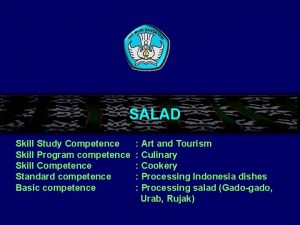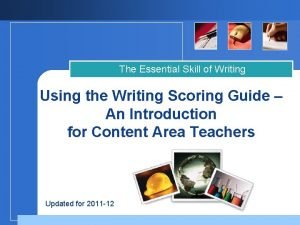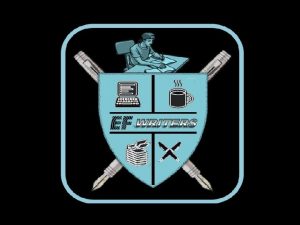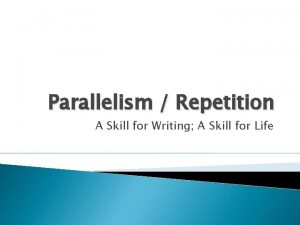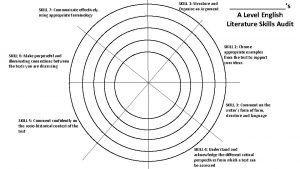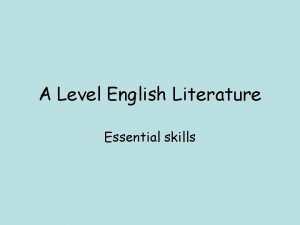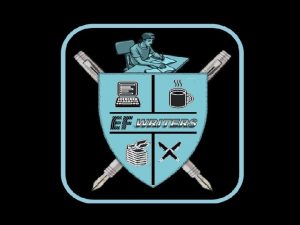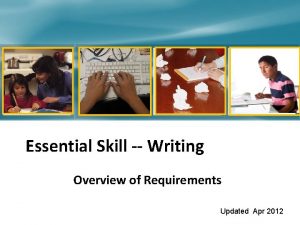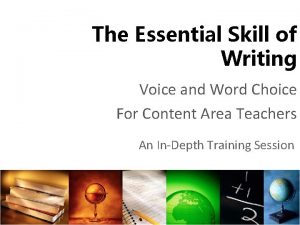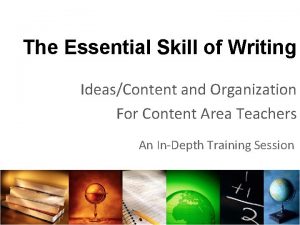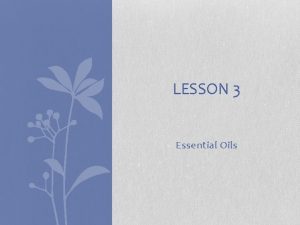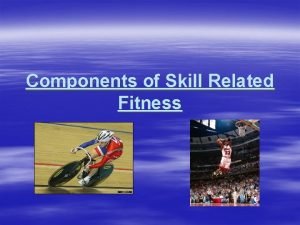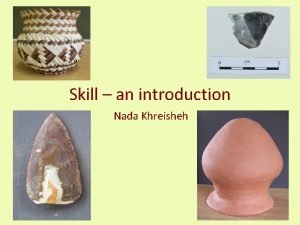The Essential Skill of Writing Using the Writing







































- Slides: 39

The Essential Skill of Writing Using the Writing Scoring Guide A Refresher Training for English Language Arts Teachers Updated for 2011 -12

Goals for this workshop 1. Review Ø Oregon’s Writing Scoring Guide Ø Classroom uses of the Writing Scoring Guide Ø Supporting colleagues in writing across the curriculum 2. Understand Ø Options for Demonstrating Proficiency in the Essential Skill of Writing for the Oregon Diploma 3. Score student papers and recalibrate to scoring standards 4. Set the stage for follow-up training

OAR: 581 -22 -0615 For students first enrolled in grade 9 during the 2009 -2010 school year, school districts and public charter schools shall require students to demonstrate proficiency in the Essential Skills listed �(A) Read and comprehend a variety of text; and �(B) Write clearly and accurately

Essential Skill Proficiency Three options for diploma requirement 1. OAKS Statewide Writing Assessment • Score of 40 or higher 2. Other approved standardized assessments • SAT Writing Assessment score of 460 or higher

Option 3 -- Writing Work Samples � 2 work samples § 1 expository or persuasive any mode (expository, persuasive or narrative – personal or fictional) �Score of 4 or higher in 4 traits on Official Scoring Guide

Essential Skill Proficiency, cont. How do you use the Writing Scoring Guide with your students?

Essential Skill Proficiency, cont. 2 How do you use the writing scoring guide to assess student writing?

Let’s Review the Scoring Guide!

The Writing Scoring Guide: Background �Developed in Oregon by Oregon Teachers �Introduced in late 1980’s �Reviewed and Updated Frequently �State Assessment since early 1990’s �Authentic Assessment �Strongly tied to instruction �High inter-rater reliability �National recognition

Six Writing Traits 1. Ideas and Content * 2. Organization * 3. Voice 4. Word Choice 5. Sentence Fluency * 6. Conventions * * Must meet score of 4 for proficiency

Writing Scoring Scale

Ideas and Content Clear Focused Enough Details Relevant Details

Organization Introduction Good Beginning Well Developed Body Reader can follow ideas Good transitions Paragraph Breaks Conclusion Well developed Satisfying ending

Sentence Fluency Easy to Read Aloud? • Supply Punctuation where natural Enough Variety? • Sentence Structure • Sentence Beginnings • Sentence Lengths Stylistic Control? • Effective fragments • Natural dialogue

Conventions Kinds of Errors Significance of Errors Proportion of Errors

Conventions, cont. q Correct end-of-sentence punctuation? § § Run-on sentences Comma splices Fragments (none or just a few effective ones) Internal punctuation q Correct spelling of common words? (grade level appropriate) q Correct capitalization?

Grade Level Expectations

Voice (Score is not required) Writer’s Voice Present? Appropriate Voice? Commitment to Topic, Mode Sincere, engaging Audience, level of formality


Word Choice (Score is not required) Specific Enough? Variety? Appropriate? Functional?

The Writing Process Drafting Revising Pre-writing Final Copy Editing/ Proofreading

The Writing Scoring Guide: Purposes 1. 2. 3. 4. Instructional Tool Formative Assessment Summative Assessment Demonstrate Proficiency in the Essential Skill of Writing to earn an Oregon Diploma

Using the Scoring Guide as an instructional tool during prewriting and drafting q Set expectations for writing activity q Teacher or peers give feedback during rough draft stage on ideas/content & organization

Using the Scoring guide as an instructional tool during editing, revising, & proofreading q Peer feedback on Sentence Fluency and Word Choice q Students self-assess on Ideas/Content, Organization & Conventions q Students complete Student Guide to Revision before turning in final draft

Formative Assessment In order to target instruction effectively, to re-teach when necessary, to offer needed support, and to provide appropriately challenging assignments, teachers must have an ongoing and accurate understanding of their students’ literacy capabilities. ” Torgeson & Miller, 2009

Summative Assessment q End of unit assessment q Final (semester) exams q Student self-assessment using writing from different times during course q OAKS Statewide Writing Assessment q Meet requirement for local performance assessment q Demonstrate Proficiency in Essential Skill of Writing to receive Oregon Diploma

Essential Skill Proficiency, cont. 2 Requirements for Writing Essential Skill Proficiency Using Work Samples q 2 work samples § 1 expository or persuasive § 1 any mode q Score of 4 or higher in 4 traits on Official Scoring Guide

Writing Work Samples What is the difference between a writing work sample and any other kind of writing?

Work Sample Design Local work samples must be designed to elicit student writing that is long enough and complex enough to be scored using the Writing Scoring Guide.

Work Sample Design, cont. What is long enough and complex enough? • sustained writing – single author • specific focus & sufficient details • intro, body, & conclusion to score for Organization • No length requirement – However, • 1 ½ - 2 pages handwritten is about the minimum

Work Sample Design, cont. 2 Expository Mode: • Explain problem, process, concept, etc. • Analysis of issues, events, speakers, etc. • Comparison/contrast • Brief research or response papers (2 -3 pages) Persuasive Mode: • Essay taking a stand on an issue • Pro/Con and call to action Narrative Mode: • Relating an experience

Work Sample Design, cont. 3 Unsuitable (NOT long or complex enough) § § § § Short answers (even a couple of ¶) Journals Logs; responses to activities or summaries Tests or quizzes Workbook or work sheet activities Book reports Group projects

Work Sample Design, cont. 4 Key to Success: Good Prompts 1. Clear, concise wording 2. Identify task and mode 3. Be open-ended 4. Be free from bias 5. Encourage fresh, original thinking

Work Sample Implementation Administration q Work samples must be the product of an individual q Work samples must be supervised by an authorized adult; q Students may not work on work samples outside a supervised setting.

Work Sample Implementation, cont. Administration q Word processed papers are permitted. q Grammar and spell-check features may be used. q Students should have time to do their best work. Generally, three one-hour sessions are recommended.

Work Sample Implementation, cont. 2 Scoring q All work samples must be scored using Oregon’s Official Writing Scoring Guide. q All raters must have been trained to use the Scoring Guide. q Only one set of scores is required for a work sample. (Districts may want more than one rater for borderline papers. )

Work Sample Implementation, cont. 3 Feedback and Revision FEEDBACK: Only 2 options 1. Oregon’s Official Scoring Form 2. Highlighting Oregon’s Scoring Guide STUDENT REVISION: 1. Students are allowed to revise and resubmit their work samples following scoring/feedback. 2. Most papers should be revised only once.

Resources & Coming Attractions q ODE Website: www. ode. state. or. us/go/ worksamples q Follow-up workshops (List any scheduled) q Contact information (List your information here)

A Parting Thought “Be yourself. Above all, let who you are, what you believe, shine through every sentence you write, every piece you finish. ” John Jakes
 What are the soft skills
What are the soft skills Using math to define the foodservice industry
Using math to define the foodservice industry Plamatic acid
Plamatic acid The life skill using community resources means
The life skill using community resources means Components of blackboard writing skill
Components of blackboard writing skill Definition of micro teaching
Definition of micro teaching System collections generic
System collections generic Dtfd switch
Dtfd switch Hình ảnh bộ gõ cơ thể búng tay
Hình ảnh bộ gõ cơ thể búng tay Bổ thể
Bổ thể Tỉ lệ cơ thể trẻ em
Tỉ lệ cơ thể trẻ em Gấu đi như thế nào
Gấu đi như thế nào Chụp tư thế worms-breton
Chụp tư thế worms-breton Chúa yêu trần thế alleluia
Chúa yêu trần thế alleluia Môn thể thao bắt đầu bằng từ đua
Môn thể thao bắt đầu bằng từ đua Thế nào là hệ số cao nhất
Thế nào là hệ số cao nhất Các châu lục và đại dương trên thế giới
Các châu lục và đại dương trên thế giới Công của trọng lực
Công của trọng lực Trời xanh đây là của chúng ta thể thơ
Trời xanh đây là của chúng ta thể thơ Cách giải mật thư tọa độ
Cách giải mật thư tọa độ Làm thế nào để 102-1=99
Làm thế nào để 102-1=99 độ dài liên kết
độ dài liên kết Các châu lục và đại dương trên thế giới
Các châu lục và đại dương trên thế giới Thơ thất ngôn tứ tuyệt đường luật
Thơ thất ngôn tứ tuyệt đường luật Quá trình desamine hóa có thể tạo ra
Quá trình desamine hóa có thể tạo ra Một số thể thơ truyền thống
Một số thể thơ truyền thống Cái miệng nó xinh thế
Cái miệng nó xinh thế Vẽ hình chiếu vuông góc của vật thể sau
Vẽ hình chiếu vuông góc của vật thể sau Nguyên nhân của sự mỏi cơ sinh 8
Nguyên nhân của sự mỏi cơ sinh 8 đặc điểm cơ thể của người tối cổ
đặc điểm cơ thể của người tối cổ V cc cc
V cc cc Vẽ hình chiếu đứng bằng cạnh của vật thể
Vẽ hình chiếu đứng bằng cạnh của vật thể Tia chieu sa te
Tia chieu sa te Thẻ vin
Thẻ vin đại từ thay thế
đại từ thay thế điện thế nghỉ
điện thế nghỉ Tư thế ngồi viết
Tư thế ngồi viết Diễn thế sinh thái là
Diễn thế sinh thái là Các loại đột biến cấu trúc nhiễm sắc thể
Các loại đột biến cấu trúc nhiễm sắc thể










































